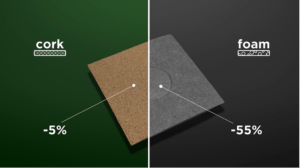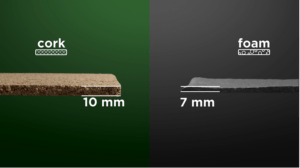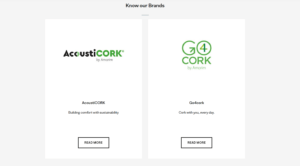(This article was contributed by Amorim Cork Composites)
The visual and design component is one of the most valued aspects when it comes to floor installations or renovation projects. However, it is important to bear in mind the base on which the new flooring will lay—the underlayment. This layer of material, applied between the concrete (or the previous flooring in case of renovation work) and the final flooring, is essential to ensure the durability of the floor over time.
Durability: A key point when choosing an underlayment
In an online survey recently conducted by Amorim Cork Composites in the American market, consumers named durability as the No. 1 reason to install an underlayment.
To better understand customer needs, we gathered the opinion of more than 300 people who planned to install or had recently installed a new floor in their home. According to the results, consumers who chose to install underlayments stated their most valued performance characteristic is the durability that this solution gives to the flooring.
Cork or 100% foam: Which underlayment provides greater durability?
Given the need for durability and the wide range of solutions available on the market, why choose a cork underlayment instead of a 100% foam-based solution? To answer this question, we carried out two different tests.
Dynamic Load Test*
The dynamic load test is a laboratory test that simulates the pressure exerted on the floor by foot traffic, trolleys and office chairs with casters, among others. To be effective, the underlayment must be able to withstand this pressure without losing its absorption characteristics.

To assess the material performance, we submitted a sample of cork and another composed entirely of foam—both 10mm thick—to 100,000 cycles at 75 KPa pressure.
Cork underlayments have shown to have a clearly superior performance when compared to the 100% foam-based solution, maintaining their characteristics. After 100,000 charge cycles, cork only lost 5% of its thickness while foam recorded a loss of 55%.
Creep test*
The creep test determines the weight that can be placed on a given floor over time, using as reference a period of 10 years. We are talking about furniture weight, for example. In a comparative test between a sample of cork and another 100% foam-based sample, the cork sample revealed to have a higher resistance to compressive creep due to its resilience. This means, as it is compressed over the years, cork maintains its thickness and, consequently, the performance of the system where it is applied, whereas with foams (PU, PE or PP), whenever pressure results in cell breakage, the underlayment loses density and effectiveness.

In short, the tests carried out have shown that a cork-based underlayment is the best option to ensure the durability and performance of the flooring for an extended period of time. Therefore, the choice of a cork solution translates into savings for the consumer, thus avoiding the need for early floor replacement. Additionally, with a cork solution users will be able to enjoy the comfort an underlayment has to offer for years to come—just like on the first day it was installed.
(*tests carried out in independent and certified laboratories)
Performance and sustainability
In addition to performance, from an environmental perspective cork-based underlayments also represent a more sustainable choice than foam-based solutions.
In the case of Amorim’s underlayments, according to independent studies conducted by EY consultant, all analyzed products have a negative carbon balance when considering the carbon capture of cork oak forests and production-related emissions. This means that the carbon capture of cork-based underlayments exceeds the CO2 capture resulting from their production.
Our brands: Acousticork and Go4Cork
Currently, Amorim Cork Composites offers a wide range of underlayments that adapt to all floor types. Whether it is a laminate, wood or ceramic flooring, there is an Amorim underlayment that adapts to your flooring needs, offering a quieter and more comfortable environment.

